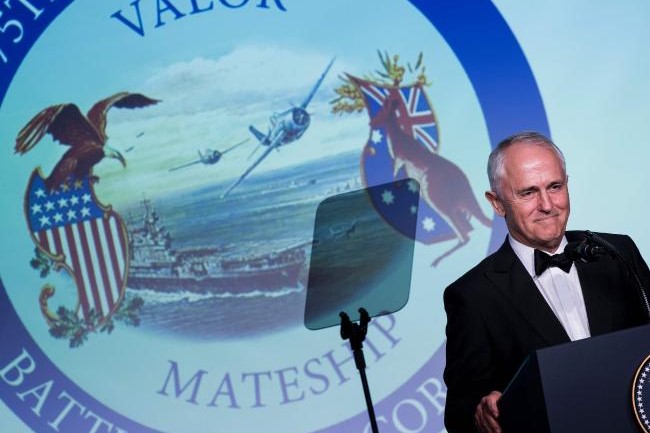AFP photo
By
Binoy Kampmark
The sea and bodies of water are as good as any in creating myths. Out of the water come creation myths: the heaving gorgeousness of Venus, emerging from raised foam, vitality captured in the enduring painting by Sandro Botticelli.
The idea of Australia being the subject of a Japanese invasion, and the need to have a muscular paternal Uncle Sam moving in to save the day provide the justifications for Canberra’s official line on the necessity of Washington’s continued presence in the Asia Pacific. That bosom was most amply squeezed during the Battle of the Coral Sea, which saw a relentless string of Japanese successes checked by a US-Australian force.
During the 75th anniversary commemorations, a persistent theme emerged: that the battle took place to prevent an invasion of the Australian mainland. Prime Minister Malcolm Turnbull gave an ample demonstration about how, in a desperate attempt to force a point, history is airbrushed of its complexity. In some cases, it is even remade to impress audiences.
In a speech on May 1 in Townsville, Turnbull laced his address with a few points crying out for qualification. “The pride of the US Navy had been sunk in a surprise attack at Pearl Harbour.”[1] Little wrong with that statement, apart from the obvious, and critical point, that the attack missed the carrier fleet which was conducting manoeuvres at sea, a point which was to prove invaluable for the rest of the Pacific war.
In the lead up to the Coral Sea engagement, Japan had bombed the northern Australian city of Darwin, taken the Dutch East Indies, and the naval base of Rabaul. Port Moresby was threatened, and if taken, the empire of the rising sun “would isolate Australia and take us out of the war to be invaded at the convenience of the new masters of the Pacific.”
This is a stretch, but it is an elastic one Turnbull is happy to take. The Japanese, he claimed, had plans that had been “discovered by American and Australian code-breakers at the Fleet Radio Unit in Melbourne, coast watchers on the Solomons and surveillance flights from Queensland and Port Moresby.” All this suggested that the Empire of the Rising Sun was gluttonously heading towards the mainland.
This chestnut has proved to be a particularly hoary one over the years. It is one taken out to be roasted at “special” events, usually at commemorations where history matters less than structured narratives of convenience, often trumpeted by the Returned and Services League of Australia.
The notion of imperilment and vulnerability must be justified; to suggest otherwise would be to challenge Australia’s losses during the conflict, and its distorting alliance with the United States. Works such as Bob Wurth’s 1942: Australia’s Greatest Peril (2008) do little to bring scepticism to the tale, making the mistake that perception must be its own, self-justifying reality.
In 2002, Peter Stanley, principal historian at the Australian War Memorial, an institution not renowned for its radical thinking, spoke of irritation about the invasion myth. “I’m sick of the myth; it’s time to knock it on the head. A lie told for war time propaganda stays with us.”[2]
While the Curtin government fantasised in apoplectic panic about Imperial Japan’s intentions, a point evident in cabinet meetings, Tokyo felt otherwise. According to Stanley, there was no Japanese invasion plan prior to 1942.
Even in 1942, drunkenly spurred on by rapid successes in the Asia-Pacific, discussions about invading Australia to prevent it being used as a base for Allied harassment never went beyond middle-ranking naval officers, some pickled by seniority. “The plans got no further than some acrimonious discussions.”
The army command, more concerned with keeping forces ready and strong in Manchuria and China in the event of Soviet invasion, scoffed at the idea as one verging on lunacy. Ditto the naval high command, accurately concerned that any such invasion would require an enormous supply commitment potentially unsustainable for the Japanese war effort.
The focus, rather, was isolating, not invading Australia. Such points were recapitulated in Stanley’s Invading Australia: Japan and the battle for Australia (2008), building on the notion that Prime Minister Curtin had essentially been in the business of scaring, not reassuring, the Australian public.
By April 1942, a point that Turnbull actually misrepresents to his unwary Townsville audience, the broken Japanese codes revealed that Tokyo had little intention of seizing the continent. Curtin, wishing to keep the levels of fear to their suitable, motivating levels, preferred to keep matters quiet as the battles continued to rage. The Curtin in Wurth’s account goes even further, coming across as paranoid and incapable of trusting the intelligence dolled up to him.
Australian vulnerability remains a matter of necessary symbolism rather than cold steel fact. It seems to have found expression in the DNA of every Australian prime minister since Curtin, the gruel of consumption each leader needs as he or she assumes power. Never entirely self-assured, Australian leaders have either leaned on Britain with childish irritability or the United States with a victim’s insensibility, desperately fearing negation on the chessboard of geopolitics.
Clinging with desperation to the coattails of a great power has also made Australian politicians disgraceful before their mighty patrons, idiotically smiling, as Turnbull did before Donald Trump, in their abode of power. Such figures are not so much guests as tolerable vassals, required to do the fighting and the dying when the United States demands succour in the grand game of empire.
[1] https://www.pm.gov.au/media/2017-05-01/remarks-75th-anniversary-battle-coral-sea-0
[2] http://www.theage.com.au/articles/2002/05/31/1022569832145.html



No Comments Yet!
You can be first to comment this post!